Welcome to seoClarity’s Technical SEO Best Practices Webinar series, where we discuss a variety of technical topics with our friends and colleagues in SEO. Our inaugural episode features our friend Catfish Comstock of BusinessOnline and covers the topic of:
SCHEMA
Why should you be excited to learn about schema, otherwise known as "structured data"? Surprisingly underused by SEOs, schema offers a valuable opportunity to increase CTR and provide users immediate information directly in the SERP.
What was once considered a manual process is made super simple with our approach, too, making schema markup easy for anyone on your team to implement (more on that in the webinar and transcription below!).
You will not want to miss the end of this presentation as seoClarity co-founder and chief architect, Mitul Gandhi, shares about the exciting free tool that helps users take the leap in implementing structured data on their own.
What was once considered a manual, time-consuming process is made relatively straightforward with the new schema builder tool, allowing users to easily build validated JSON-LD structured data markup for any web page.
Webinar Video Transcription
Table of Contents
- What is Structured Data?
- Why is Schema Markup Important?
- Increased SERP Visibility: Schema Examples
- Is Structured Data a Ranking Factor?
- What Makes Schema so Hard to Implement?
- How to Implement Structured Data
- What is JSON-LD?
- Schema Opportunity: What Types of Schema Are Supported by Google?
- How Featured Snippets and People Also Ask Play into Schema
- The Most Common Schema Types
- How to Identify Opportunities for Schema
- How to Track Success and Performance
- Why Schema is Hard to Implement at the Enterprise Level
- Solutions to Help Implement and Execute Schema
What is Structured Data?
Mark Traphagen: So let's start out - now we don't have the word schema on this first slide. We're talking about structured data. Why are we talking about that?
Catfish Comstock: Well, structured data is just a standardized format for providing information. And so a lot of people in the SEO community conflate structured data with schema implementation. We'll talk a little bit more about schema specifically in just a second, but structured data in general is just a standardized format for data. One of the ways that you can communicate that is through a standardized vocabulary of terms, and that is referred to as a structured data vocabulary - of which schema.org is one.
There are other vocabularies, but schema is the one that has surfaced as the primary and preferred vocabulary that search engines recognize and use in terms of taking that information and then enhancing search results. So that's what we're going to be focused on today: How to implement the schema.org structured data vocabulary on your site in order to provide greater enhancement and visibility to your search listings, and ultimately how to drive more traffic to your site via organic search.
Why is Schema Markup Important?
MT: It would probably be good to ask you: Why does it matter? What's important about schema markup?
CC: Well, you can see from the examples here that schema markup allows the search engines and specifically, Google and Bing (if you're in the US), to better understand your data, better understand which parts of your data might be relevant for particular enhancements that the engines have for different types of structured data. It makes it easier for content to be understood and relevant for Featured Snippets, for example.
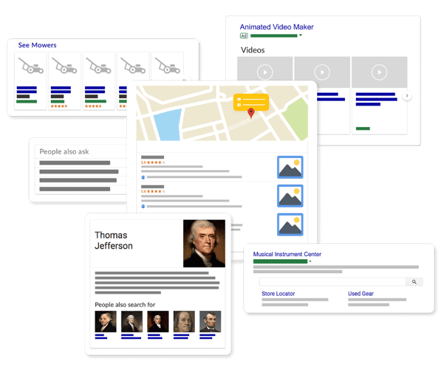
Ultimately what we're saying is that in order for you to maximize your opportunity to get your information in front of Google and for them to evaluate it in all of the different contexts that it could be presented, it behooves you to implement structured data schema so that it makes it easier for the engines to understand where and what all that data is. A lot of times the engines can infer that by themselves, but in a lot of situations they cannot. And so what we're trying to do is make it easier for them to do so.
Recommended Reading: Schema Markup Generator: Implement Structured Data Without Developers
Increased SERP Visibility: Schema Examples
CC: In this particular case, you can see that we have an aggregate review on a software app from Pizza Hut. So again with this type of situation, you can see the schema type underneath there and how it displays the rating in the search results, and it has the number of votes and some other information there that - if you didn't have the schema implemented - that would not appear. And of course, when it does appear, that's quite likely to increase your CTR.
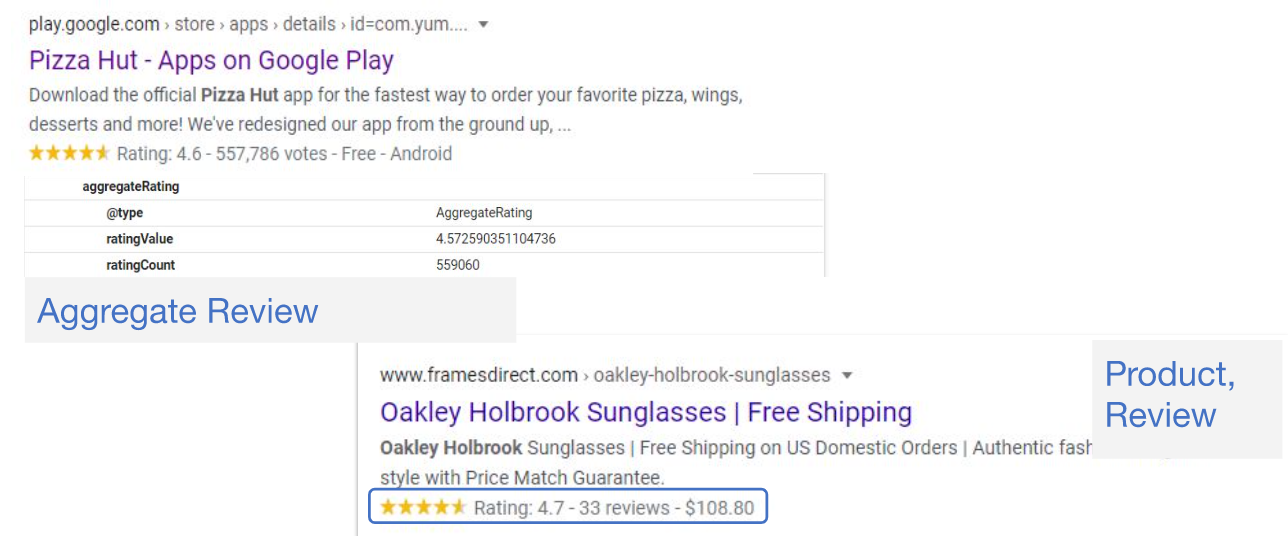
It also gives folks more information for them to make a better decision on whether or not they want to visit your site. So, this is just one way that schema is displayed. The bottom one is a product review which again is also an aggregate rating, but in this particular case, it's not about an app it's about sunglasses.
You'll also see the breadcrumb there as well, which can also be augmented with schema. So there's a number of different ways, if you're selling products, that you really have to be mindful of for your strategy of scaling schema implementation in order to maximize your opportunity for these kinds of listings.
This is a local map. And then again, underneath that local pack you see there's some in stock information around a particular product, having to do with earbuds. Again, an aggregate review is there. These are all the different kinds of ways that Google takes information and displays it.
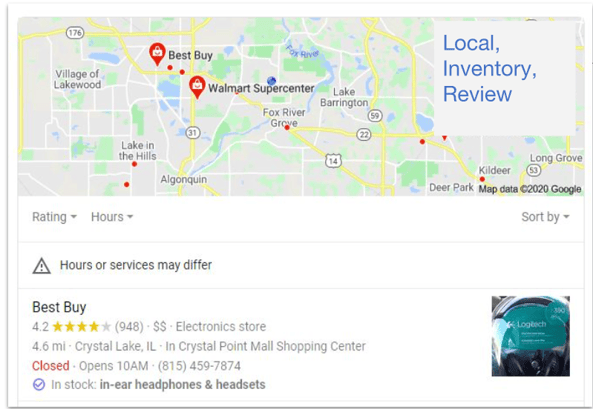
Now, the review is a rich feature that you need the schema for. You can be featured in the local pack without schema, but again, using the schema information to ensure that Google and other search engines have no questions or inconsistencies is a critical reason why you want to implement schema.
In this particular case, we've got an event - you can see that the different events are listed there underneath. The one on the bottom right is really pertinent for a lot of folks because it's the implementation of FAQ schema or common questions regarding a particular page.
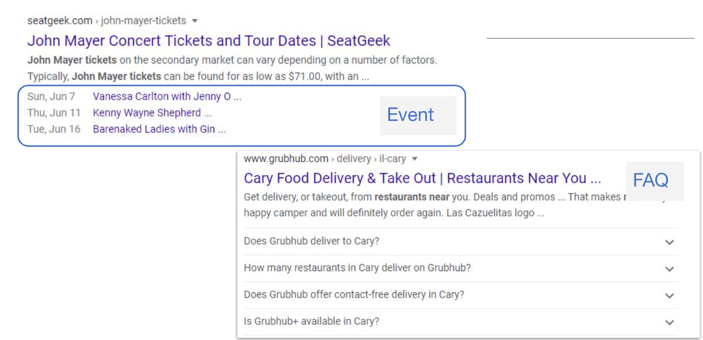
In this example, you can see that there are some common questions that folks are asking about Grubhub, and those answers are right there in the search results based on that schema. And so, not only is this more effective at answering potential questions that people might have about your business, but that extra screen real estate can differentiate you in search results and get you the click and or the business.
Recommended Reading: Looking to Capture Search Visibility? Implement the FAQ Schema.
This is an interesting example because these are two different kinds of Featured Snippets. You'll notice that the video clip on the left is actually a suggested clip. Google has actually processed the transcript and figured out that within the context of this video, the answer to the query is at 88 seconds and that's the recommendation. And then on the right, you're seeing a sort of a one, two, three, etc. list of different things that come back for the query.
 Both of these types of Featured Snippets can be acquired without the implementation of schema, but implementing schema on these pages where the relevant information is allows the search engines to ensure that they understand this content within your site, and it makes it eligible to compete for these listings.
Both of these types of Featured Snippets can be acquired without the implementation of schema, but implementing schema on these pages where the relevant information is allows the search engines to ensure that they understand this content within your site, and it makes it eligible to compete for these listings.
Is Structured Data a Ranking Factor?
MT: So looking at Featured Snippet results here, and since they capture so much screen real estate, so much SERP real estate, and tend to often be the number one position for any query, a question that would naturally flow is: Does schema help you with ranking?
CC: So it does not currently help you with ranking. In other words, if you have your information marked up in schema and somebody else doesn’t have their information marked up in schema for Featured Snippets, that's not going to be a ranking influencer as to who owns that Featured Snippet. However, for other rich results outside of Featured Snippets, it's a requirement to be eligible to compete for the listing. And so, again, in and of itself, it is not a ranking factor, but it opens doors and ensures that your content is being correctly processed so that you can be eligible to rank. Without that implementation, you would have far less opportunity to do so.
MT: Increasing your eligibility is becoming so important. Here at seoClarity, we're looking a lot at actual search visibility: Where you appear in the search results, and what's above your traditional organic results. Being able to be eligible for some of these search features can be very important because sometimes they're the only thing that people see when they go to a SERP.
CC: Right - and especially for a lot of folks out there where if they look at their Google Search Console and take a look at the queries that are driving traffic, they may find that the brand related queries are really what's driving a great deal of their search traffic. In those particular cases, you really want to be diligent about figuring out which search enhancements and especially what's coming up in the knowledge panel for those searches, because oftentimes people are making a value judgment on your company based on that information. They never even click over in some cases to your site. So organization schema is critical for that reason to implement on the homepage of your site and make sure that it's up-to-date and consistent so that you're putting your best foot forward for people who are specifically searching for your brand.
What Makes Schema so Hard to Implement?
MT: So we've looked at a lot of advantages of schema and what it can produce, what it can do for you in the search results, but probably the biggest thing holding people back is some of the challenges and difficulties with implementing it. So why is it so hard to implement?
CC: Well there is a complexity of implementation. So depending on whether or not you're using microdata or JSON-LD, it becomes difficult at scale to implement. Then just the evaluation of what types of data to mark up and how to prioritize that becomes an issue also; especially when you couple it with the fact that many companies don't understand the value (yet) of what schema can bring to the table.
Because it's foreign also to developers, sometimes it's hard - especially with enterprise companies - to get traction for their IT teams to implement as a priority because there are so many competing agendas. It's also hard to keep up with the search engines, especially Google, because there is a lot of change. This is a landscape of consistent and constant change and development right now. And it's not the same for every search engine. Although if you're using JSON-LD as your primary vocabulary, that's going to go a long way in ensuring that all the search engines are on the same page in terms of evaluating your schema.
Bing doesn't recognize nearly as many enhancements as Google does right now, and knowing which of those is which and how to track it and how to show value behind the implementation can also be a little bit tricky if you're just getting started with this.
And of course different keywords, different industries, have different opportunities and different things that they should prioritize. So, it's a sort of complex landscape that requires a lot of research and a lot of due diligence. And for that reason it's easy for it to consistently get pushed to the side as something we'll do next month, or a lower priority than some of the lower hanging fruit that there might be within an IT development queue.
So, How Can You Implement Structured Data?
MT: So it has its challenges, but it's not impossible. So let's move on to a little bit of how you would go about implementing structured data at the fundamental level. We'll go more in-depth about some tools that you can have later on to help you do this, but let's get into the nitty gritty of what it looks like.
CC: So as we talked about before with these structured data vocabularies, JSON-LD is really the preferred structured data vocabulary that Google recommends. They also recognize microdata and RDFa, but the future and where schema is going is really centered on JSON-LD. The reason for that is because if you look at the microdata example here, you can see that in order to implement it, you actually have to get into the HTML code and add item scope and item types to div tags and so forth.
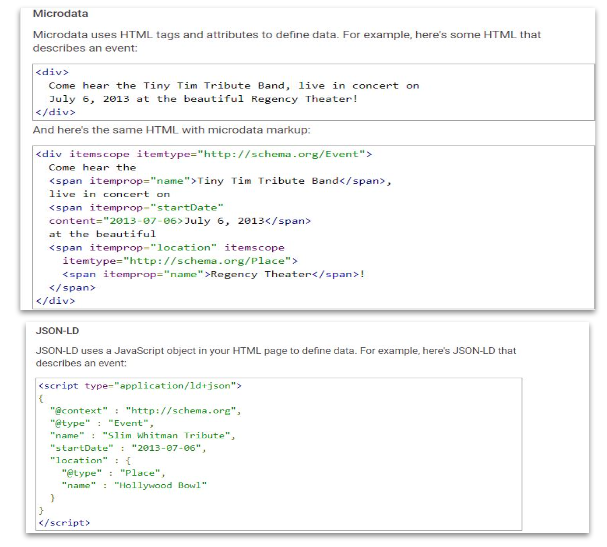
Whereas JSON-LD is more of a script-based language, and so you can just take that entire script and insert it, make changes at scale, and it just becomes a lot easier to use - especially for enterprise teams on an ongoing basis. Especially if things change and new data types are added, there's just a much greater degree of scalability around JSON-LD. So, that's the primary recommended vocabulary right now that we would recommend.
Tip: Implement schema across thousands of pages while bypassing the dev team with Schema Optimizer.
What is JSON-LD?
MT: Since you're recommending JSON-LD, let's plunge into that a little more deeply - give us a little bit more detail on that.
CC: Let me take a step back because I think I may have misspoke earlier. There is a vocabulary and then there is a markup format, and I think I just inadvertently referred to JSON-LD as a vocabulary, whereas really it's a markup format. So let me just take a step back and be clear about that. What we're saying is that we have a standard data vocabulary that is schema.org, and there are three ways to implement that in various markup formats that Google will recognize. Now Bing recognizes a few additional formats, but these three - JSON-LD, the microdata and the RDFa - those are the ones that I can't recommend anything outside of that because of course Google is the largest search engine and we need to ensure that we're compliant.
But the reason again that JSON-LD is preferred by Google is because it is easier to scale in terms of what format is easiest to implement. John Mueller from Google has said as much that they prefer this format and they believe this is the future of where it needs to go. So just to be clear: The format that's preferred is JSON-LD, the structured data vocabulary that we're using is schema.org.
Schema Opportunity: What Types of Schema Are Supported by Google?
MT: All right, let's move on to the opportunities (the exciting part here) and get focused because there's a lot of different - if you go to schema.org - there's a lot of different schema types, a ton of different schema types, new ones being added all the time. Not all of them are going to be useful to us in SEO and not all of them are going to be useful to everybody in every vertical or every type of business or for every type of query set. So let's get a little bit more focused now on where we should be looking for the opportunities and let's start with: What does Google actually support?
CC: There are a number of different schema types that can produce search enhancements similar to what we saw earlier in the examples. There are also different schema types that don't necessarily produce those enhancements directly, but they still influence search results and influence display.
For example, the organization schema will influence the knowledge panel, but that's not necessarily a search enhancement on the 10 blue links per page, if you will. Whereas, the article schema ... that will not only allow you to get certain enhancements, but it will allow you to be more eligible to be featured in things like Google News and things of that nature. So each one of these schema types has its own sort of parameters and set of best practices and expected results.
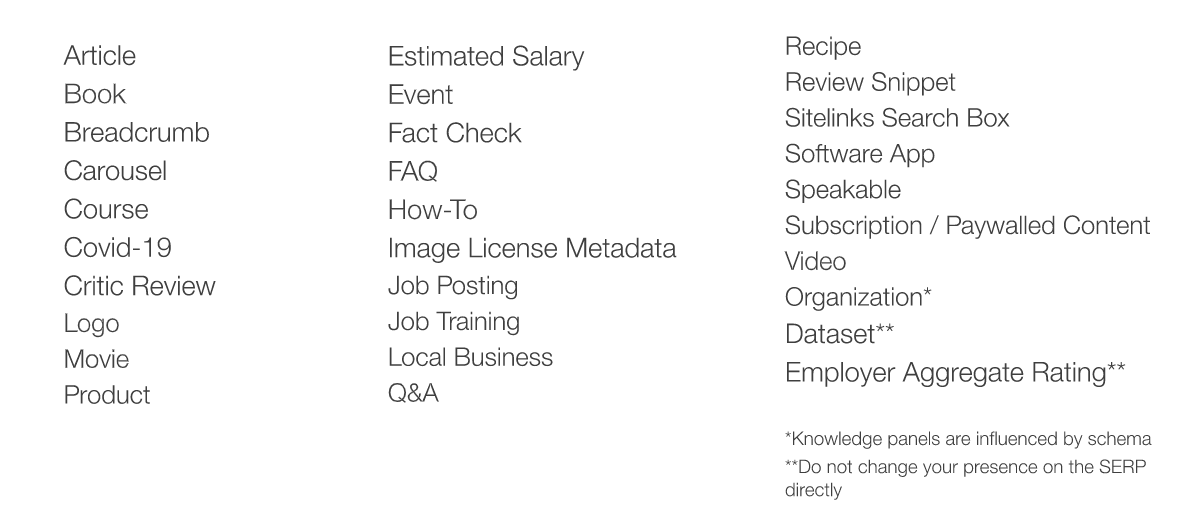
It's really important for folks to evaluate each one of these in order to see which are most applicable to their business. Now it's worth noting that these are the scheme types that are supported by Google. But if you go to schema.org, there are a huge number of schema types that live outside of this, that at some point Google will most likely adopt. When they do, those enhancements that they create around those new schema types will then be part of this list. But as it stands today, this is the comprehensive list that Google currently supports and that has an opportunity to produce enhancements.
How Do Featured Snippets and People Also Ask Play into Schema?
MT: We talked a lot in the examples about Featured Snippets, and we also saw things like People Also Ask - these things that take up, again, so much search real estate - we didn't see any schema types for those in the previous slide. So how do they feature in here again?
CC: Well, remember that Featured Snippets can be any number of different sorts of datasets. In some situations, you're going to have a definition. Those are typically produced using FAQ schema. There might be a "how to" list - that's “how to” schema. You might see a video, you might see an image. There's a number of different Featured Snippet types.
There's not one schema type it maps to Featured Snippets, there's actually numerous schema types that map to featured snippets, and depending on the query and what Google thinks is in the best interest of the user for an answer to the query, they're going to choose a different schema type appropriately. A it's almost impossible to understand all of the different keywords that are out there and all of the different potential schema types. So really what you want to do is evaluate your content, and try to understand all of the different ways that you can mark your content up with a schema that maps to those various things that we saw on the previous image.
MT: So it's sort of analogous to a lot of what we do in technical SEO and content optimization where we're trying to make our site more sensible and useful for our users, but also for the search engines - for them to be able to understand what our site is about. What's the value there? What should map to different queries? We're really doing that same sort of work here.
CC: It's almost like canonical tags, right? This is the thing: In SEO the general rule of thumb is if you can avoid letting Google make decisions for you, you're better off doing so. Now they have very sophisticated algorithms - that means that they get it right a lot of the times. But in many situations they don't. So in order to ensure that your information is being consumed in the way that you feel is most applicable to what you're presenting, the implementation of schema just really eliminates any ambiguity as far as how Google might perceive your data, and it makes it easier for them, again, to match your data up to the various types of data that they're using for search enhancements.
What Are the Most Common Schema Types?
MT: Let's focus on the most common schema types that we should be paying attention to. And why?
CC: So the organization schema is really important for the knowledge panel, and then with images and video … I have customers where they're getting almost as much image traffic for shopping - they're a B2C client - as they are through regular queries. And so in order to ensure that their images are not only appearing in image search, but they're appearing with a product label that increases click-through rates and facilitates sales based on image search, you're going to want to make sure that the product schema is configured appropriately on pages like that. Part of that product schema declaration will be around the image. And then outside of that, there's a ton of opportunity just around image search. So images and videos, those tend to drive a lot of traffic in and of themselves.
So of course we want those to be marked up and used where appropriately, and any thumbnails that might be generated as a result of that. With reviews, we've already seen in the examples - especially for shopping sites - the power of reviews is as well known. You want to make sure that that data is visible. And then again, the “how to” and FAQ schema, that will help you not only with Featured Snippets and People Also Ask questions, but it will make that content eligible for voice search in the Google Home assistant and other Google voice applications. So the “how to” and FAQ scale forward to voice-related queries as well. Then there's some advanced things that you should be looking at (depending on who you are). Combining amp with schema - especially if you're a publisher - is a critical thing to be looking at.
If you are a large enterprise site, managing your schema with Google Tag Manager is also something - especially for pages that are dynamic in nature - that might be of keen interest in order to scale effectively.
How Do You Identify Opportunities for Schema?
MT: As SEOs, once we understand an opportunity that's out there, we want to find what are our opportunities for it. So let's move on to that. Let's talk about how we identify specific opportunities that are relevant to us for implementing schema.
CC: If you're fortunate enough to be an seoClarity user, you know that you already have a ranking tool that allows you to scour not only the keywords that you've defined for your campaign, but also all of the keywords that you might be looking at from a research standpoint. You can identify these various opportunities in terms of potential search enhancements, which of your keywords are showing listings that have those enhancements, and how many of those enhancements do you currently own versus your competition.
That in and of itself is probably the best place to start. If you don't have that capacity with your MarTech stack currently, the thing to do would really be to take a look at what are the keywords that are driving traffic to my site, where I've seen real performance, both from SEO and a PPC standpoint, and then manually visiting those keywords - at least, many of them - is also a highly recommended task. Even though you might have ranking reports for these keywords that identify universal search result opportunities, there are many situations ... especially because as we know, Google now is on a machine learning algorithm.
We're at the point where we have almost keyword specific ranking criteria and output. Every keyword has the opportunity, potentially, of having sort of a different top tenth look and feel, and the opportunities that would be there would be unique to that term. So evaluating your top performing terms to look for those opportunities is the first step. And then also taking a look at your existing content and the content that you have scheduled to be produced, and trying to understand which buckets that set of content falls into in terms of schema types. That's another way to go about looking at how to scale the implementation of schema across those various types of content.
Lastly, if you're an advanced SEO and you understand entities and you're trying to ensure that you're being associated with various entities, there's opportunities there that you're going to want to take advantage of in terms of prioritizing schema for that purpose. (But that's an advanced use case that's probably more pertinent to our next webinar as opposed to this one.)
So I would say just for most people, if they don't have seoClarity ranking capabilities that will allow them to figure out where these things are, they want to just look at what's performing and also what types of content do we have and how do we scale the implementation of schema across those types.
How Do You Track Success and Performance?
MT: So again, returning to the SEO process, we now understand something that affects the appearance of our search results for our users. We know something about how to implement it. We've looked for how to find the opportunities that are particular for us to prioritize where we should implement first. Then the next thing we're going to want to do as SEOs is think about: How do we track performance? How do we show that we've made a difference for all of that investment?
CC: There are a number of different ways, and of course you want to start with your Google Search Console because they're under the Search Appearance tab. You're going to see a lot of these enhancements and the clicks, impressions, click-through rate, and position of those things. That's a great place to start in terms of understanding what's working, what's not ... and there's another section within Google Search Console that will show you if any of your schema have any errors or warnings based on the implementation.
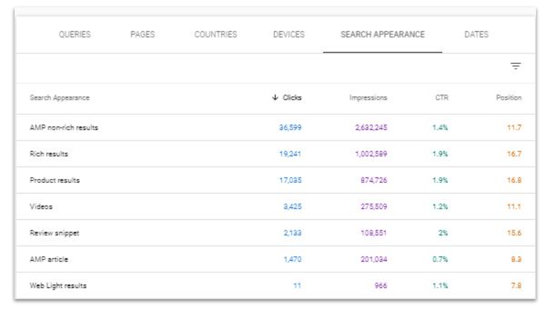
Then from that, if you have seoClarity, you can see where you are ranking for all of these things, both before and after implementation. You're going to want to do a baseline immediately on all your schema types and then as you implement, understand what that change looks like so that you can try to correlate any shift in rankings or any ranking enhancements to traffic, to the pages that those enhancements point to. That analysis of course is usually done through your analytics platform, which again, if you have seoClarity is pulled into the data set for your evaluation.
So, without trying to sound like an seoClarity commercial, there are a number of features that the tool offers that allow this type of tracking of success and performance to be much easier than it otherwise would be manually - but you can do it manually. The first place to start, would be the Google Search Console Search Appearance tab, as well as the specific tabs that are related to the errors and warnings of the schema implementation.
Why is This Hard to Implement at the Enterprise Level?
MT: We talked before ... we gave some hints about why schema can be a challenge, but at the enterprise level, where you work and where most of our clients work, it has some particular or unique challenges - let's cover some of those.
CC: At the enterprise level, of course, there's a high propensity to have multiple platforms, multiple websites, in some cases, micro-sites, there's a lot of keyword governance issues and who's going to own what, and then to the last point that we were just talking about, how do you track that across that landscape and provide visibility to different teams that might be competing for different mindshare of the same keyword.
So there is definitely a minefield potentially of issues there that you have to work through in order to just plan and create a strategy that's going to be acceptable to all parties. Then you have to keep up with - usually at an enterprise-level organization - a huge amount of content that's being produced on an ongoing basis, and you have to keep track of where all that is and what it is, and how can you scale the implementation in such a way that it becomes part of the process.
Typically what we find is when we start to work with enterprise clients, we have a retrofit where we have to look at what do they have today, and how do we get that optimized with schema? Then, what are they producing on an ongoing basis? How do we inject that optimization into the process of creating the content so it hits live immediately with schema as appropriate.
And then of course, keeping it updated. All of the different ways that schema has changed over the last year and promises to change over the next, how do you keep track of that and make sure you're maximizing opportunity at scale? That's the other thing with the enterprise-level clients where it really takes an ongoing strategy and it really takes a consistent evaluation of what's going on in the space to understand that.
For example, Google just came out with core vitals. Part of that announcement was that you no longer have to be an AMP page, as long as you're somewhat amp-compliant in terms of speed to have one of your articles considered in the top stories carousel. Those are the types of changes - not that that would necessarily change your schema or your article implementation - but that's just an example of the types of changes that are ongoing and the types of things that you have to be aware of in your strategy when you're thinking about schema and what you expect and what the competition is.
What Solutions are Available to Help Implement and Execute Schema?
MT: When you're at the enterprise level, any solution or any thing that you're looking to implement has to be scalable - scalability is critical. So let's move on to talking finally about some of the helps that we might turn to, to get that type of scalability.
CC: If you need the support, you can find someone like myself or the company that I work for, or any number of other companies - agencies, if you will - that provide those services as well as developers who have that expertise. You can bring in just specific SEO consultants to do that, that same sort of thing. Or there are a number of tools out there that provide some help with that solution.
In order to give folks a better understanding of what that tool set and that MarTech landscape looks like, it might be a good idea to bring in our extra special guest, and a good friend of mine for the past 13 years, Mitul, and let him speak about the different tools and the value proposition - what we're doing here today.
Mitul Gandhi: Hey, Catfish. Hi, Mark. Thanks for having me. Following up on what you were saying, Catfish, there are a couple of really, really good tools out there for marketers who are directly working on implementing schema. One of the key challenges that we've seen though with enterprises is that typically the person who is going to build or needs the schema implemented is completely different from the person that was going to implement and work on it.
In large organizations, the versatility and the ability for lots of people to jump on and be able to use the tools - get up to speed about it - is critical. So, we built our own. This is what we call Schema Builder.
We built Schema Builder to allow anyone - whether it be a marketer or a developer, or a novice or an expert - to quickly, easily, and correctly add validated JSON-LD schema to any webpage on the internet.
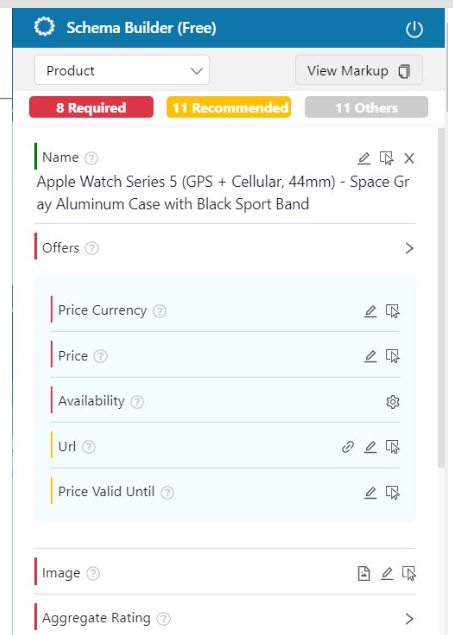
It could be on their production site, or it can also be on their Dev site if it's in their pre-production environment. The real power of this is there's a whole bunch of different schema types that we support in it right now, and we're planning to support pretty much every single schema type that Google offers. It's literally a point and click interface, and it's built to allow anyone to see what exactly are the required elements of the schema type to choose, and which ones are the recommended or optional.
Just in an effort to make it very easy and get over a lot of the barriers that you talked about with implementing schema, keeping it updated, or teaching somebody how to actually implement one of these without having to go through.
CC: Let's not forget validating code because anybody that's ever done this, that's accidentally put a curly bracket in the wrong place and then spent two hours trying to figure out where that is!
MG: For just taking out all of that human error element of it and making it so that it's just point and click and it validates it for you.
But this is not all. This is a completely free Chrome extension that is available to anyone - so share it with your colleagues. We're excited about it, but hand in hand with this, schema is absolutely an integral part of how search engines and others will consume data. And with that, we're also launching a completely new site to go along with it. So if you need more information on schema, we've got an entire site dedicated to it: schema.dev.
This is built so that you have free tools available to not just build schema, like Schema Builder, but even to test it. We have a full API for testing, so you can actually submit pages to the API and get it back in a formatic results you can ingest in your dev processes and even deploy schema on your site. This is also free and available to anyone - and we are looking for support from the community for this. So please join the community on support.schema.dev. Contribute to our roadmap. We're here to build and give back to the community with this effort.
CC: So basically what you're saying is tell us what you want and we'll give it to you.
MG: That's pretty much how it works with seoClarity, right?
CC: That's awesome. It does, in fact.
MG: The new schema types that Google is introducing and has been introducing are critical to every marketer. No matter which industry you're in, there's eventually a schema that will be relevant to you. In fact, there's a quote here from John Mueller about Google and structured data where they say in the near future, they do expect more types of structured data to be added. So this is the right time for everyone to get in. If you're not leveraging this, if you are not familiar with this, if you're worried, scared, or afraid of even jumping into this, we're here to make it easy for you.
Hopefully, collectively, we'll come up with a bunch of different things to make it super easy to deploy. Of course, there's also - if you need expert expertise in implementing this - there's BusinessOnline ... who are experts at doing this and validating it so they are available as experts also.
CC: I appreciate that. We are an enterprise-oriented SEO company that typically does year-long program management and as part of that service set, obviously we look to maximize schema implementation for our clients. Super, super excited about the opportunity to augment our process with your new tool, because to your point, it makes it so much easier for the people who are doing this to just create valid code with a point and click interface.
MG: Well, thank you - and a special thank you from all of us at seoClarity to Catfish Comstock from BusinessOnline for joining us today. Thank you for sharing all your expertise, your experience over the years, and just getting us excited about this - this great new opportunity. So thank you for joining us, Catfish.
Conclusion
I hope this was useful to you! I'd love to hear from you about what was best for you in this webinar, what you think we could have covered better, and what you'd like to see us talk about in the future. And there will be more from seoClarity on this topic and more in the future, so be watching for that in future content.







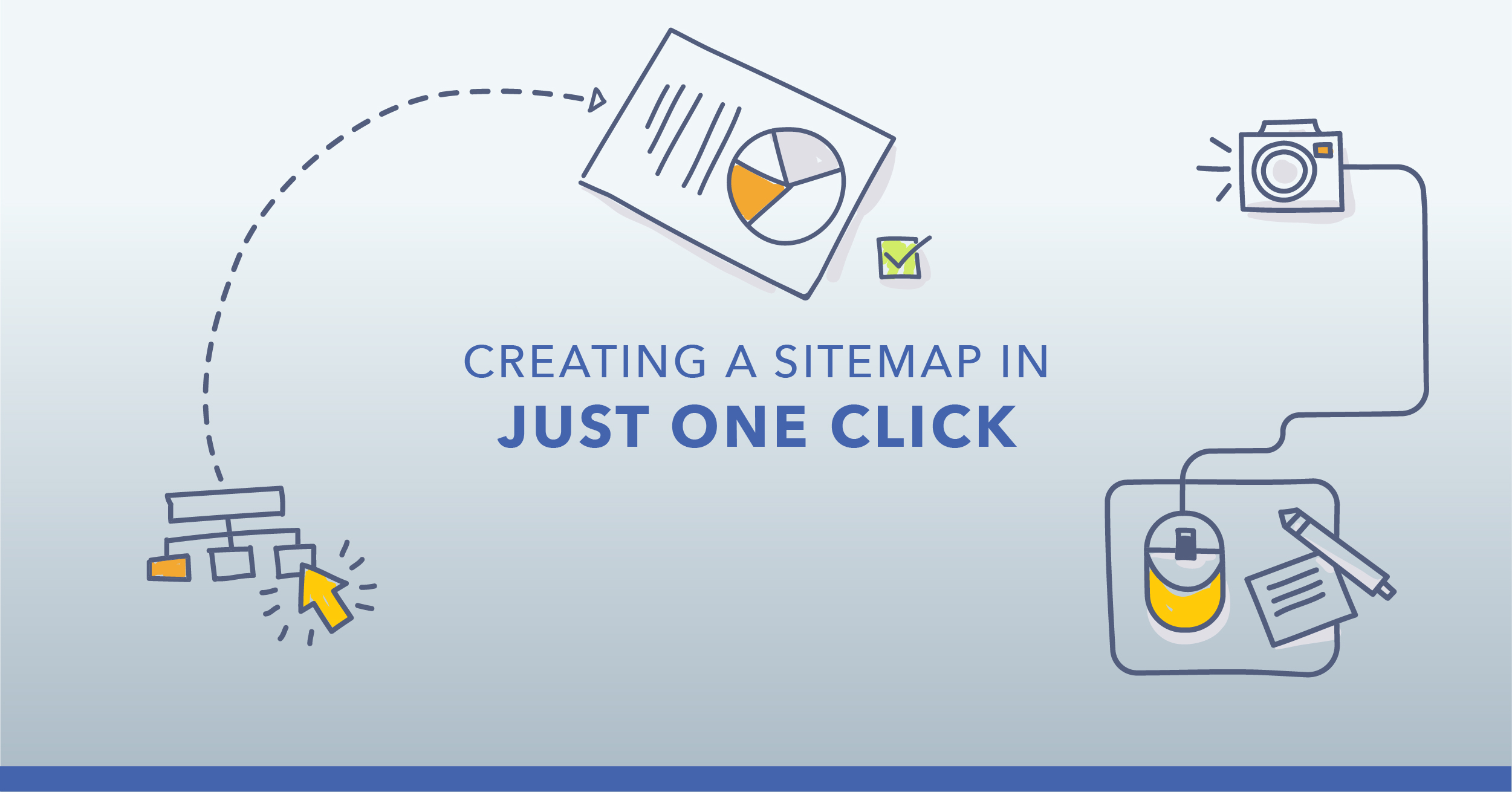
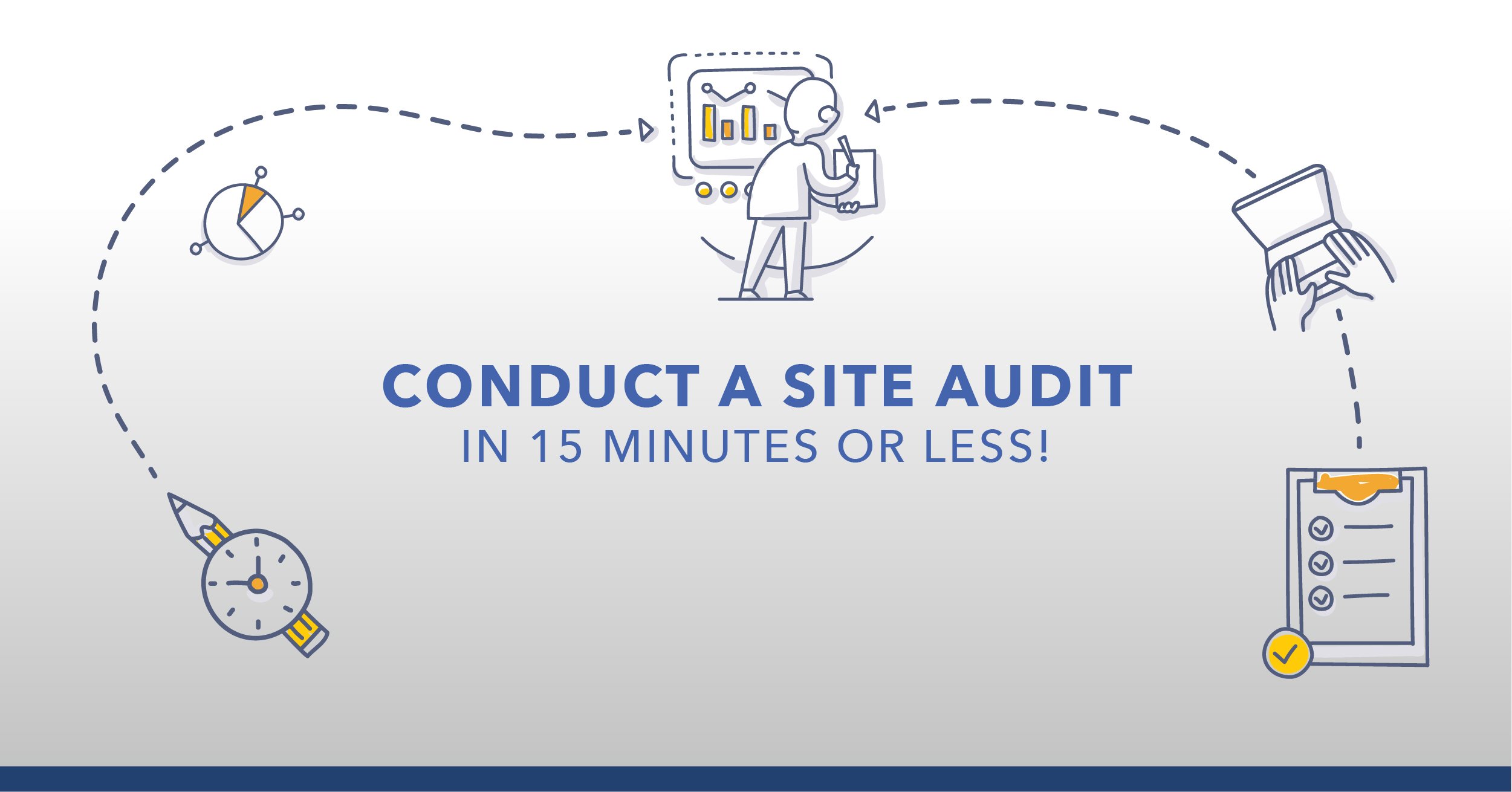

Comments
Currently, there are no comments. Be the first to post one!